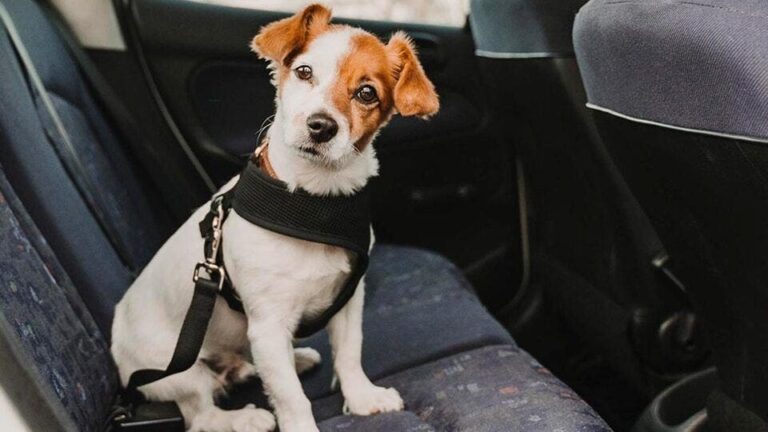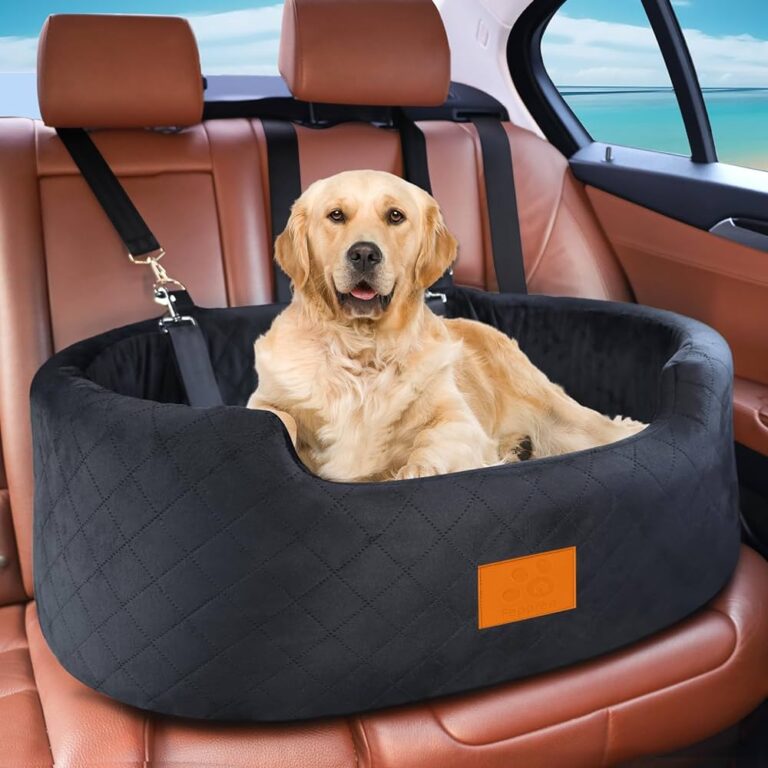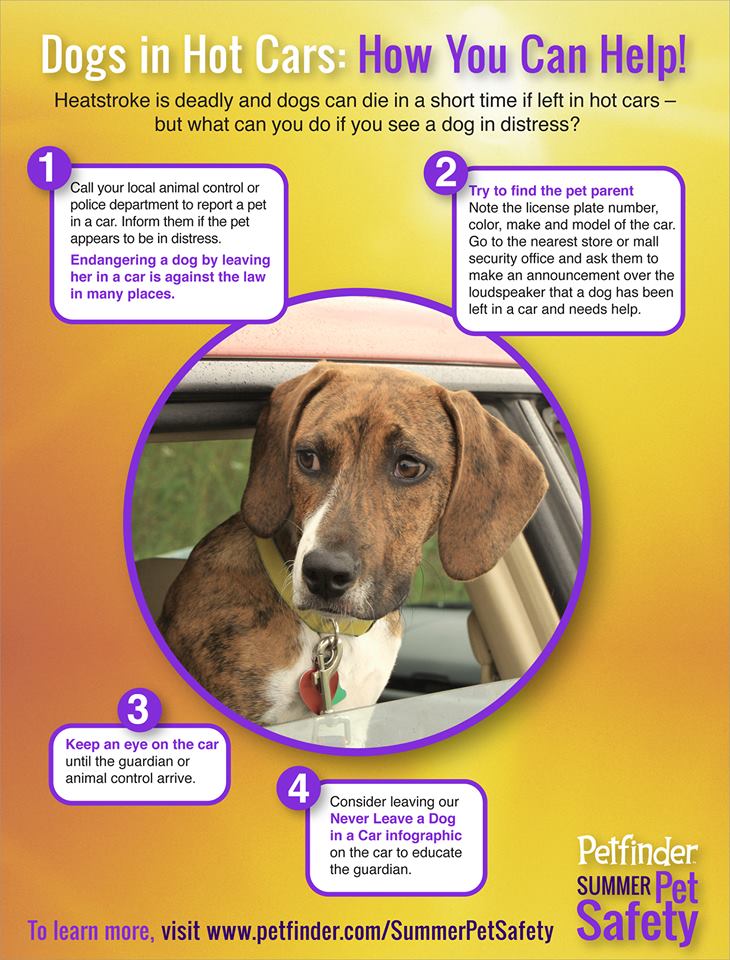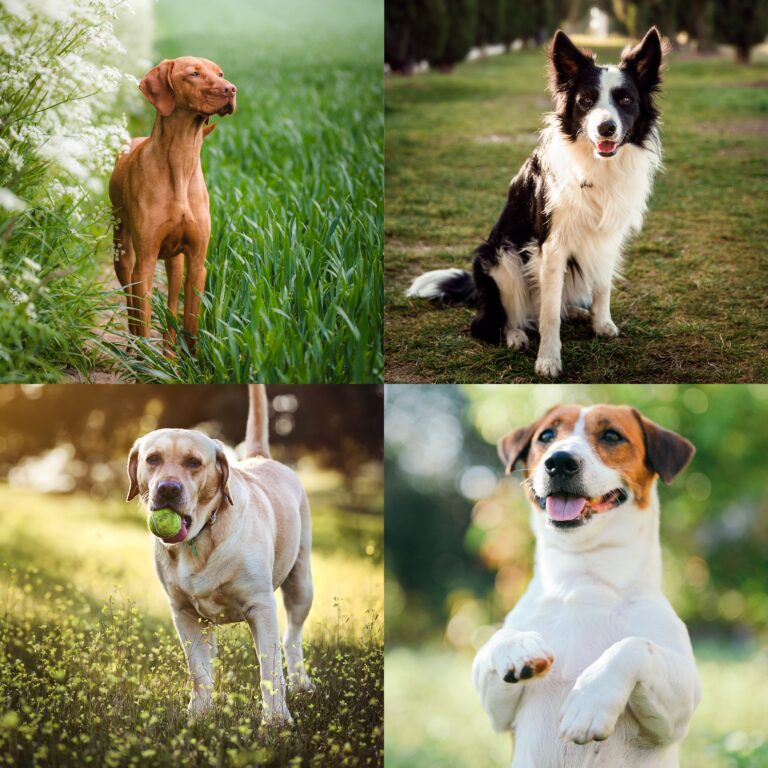What is the Safest Way to Travel With a Dog in a Suv?: Ultimate Guide
The safest way to travel with a dog in an SUV is by using a crash-tested pet travel crate securely anchored in the vehicle. Additionally, you can use a dog seat belt or a pet barrier to ensure your dog’s safety and prevent distractions while driving.
It’s crucial to place the crate or restraint system in the rear area of the SUV to minimize the impact of sudden stops or accidents on your furry friend. By following these safety measures, you can enjoy a worry-free journey with your dog, knowing that they are secure and protected during the ride.
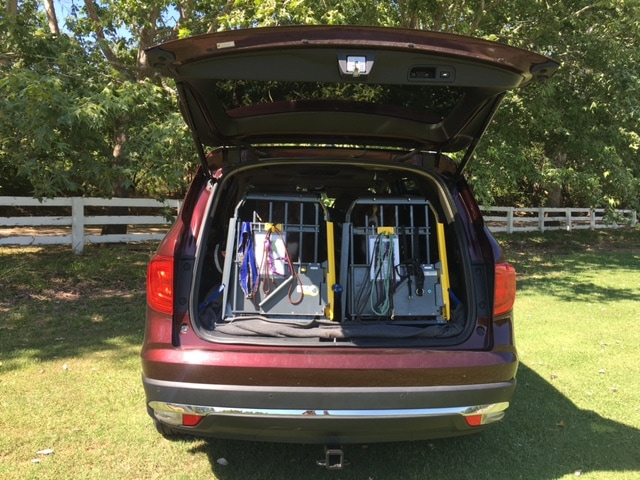
Credit: www.2coolbcs.com
Introduction To Safe Dog Travel In Suvs
Traveling with your dog in an SUV can be safe and enjoyable with the right precautions. Discover the safest way to travel with your furry friend, ensuring their comfort and security throughout the journey.
Traveling with pets can be a great experience, but it’s important to ensure their safety during the journey. When it comes to SUVs, there are a few things you can do to make the ride safer and more comfortable for your furry friend. In this blog post, we’ll discuss the importance of safe dog travel in SUVs, the common risks for dogs in vehicles, and the safest way to travel with a dog in an SUV.Why Safety Matters
The safety of your dog should be your top priority when traveling in an SUV. Accidents can happen at any time, and it’s important to ensure that your dog is secure and protected. In addition, an unsecured dog can become a distraction for the driver, increasing the risk of an accident. By taking the necessary safety precautions, you can ensure that your dog is comfortable and secure throughout the journey.Common Risks For Dogs In Vehicles
Dogs can face a number of risks while traveling in SUVs. Some of the most common risks include:- Unsecured pets can become a distraction for the driver, leading to accidents.
- Dogs can suffer injuries if they’re not secured properly during sudden stops or collisions.
- Dogs can become stressed or anxious during long journeys, leading to behavioral issues and health problems.
- Dogs can suffer from heatstroke if they’re left in a hot car, even for a short period of time.
The Safest Way To Travel With A Dog In An Suv
The safest way to travel with a dog in an SUV is to use a crate or a harness. A crate provides a secure and comfortable space for your dog, while a harness keeps your dog secure and prevents them from becoming a distraction for the driver. Additionally, you should ensure that your dog has access to water and is not left alone in the car for extended periods of time. By taking these precautions, you can ensure that your dog is safe and comfortable during the journey.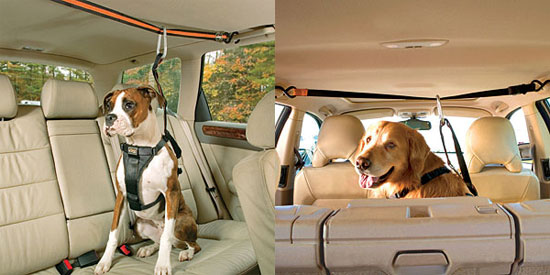
Credit: www.batcopetsitting.com
Choosing The Right Dog Restraint System
Choosing the Right Dog Restraint System is essential for ensuring the safety of your furry friend when traveling in an SUV. Whether you’re heading to the dog park or embarking on a road trip, it’s important to have a secure and reliable method for restraining your dog in the vehicle. Here’s what you need to know about selecting the safest dog restraint system for your SUV.
Harnesses Vs. Carriers
Harnesses: These are designed to secure your dog by attaching to the seat belt or LATCH system in your SUV. They allow your dog to move around comfortably while preventing them from roaming freely in the vehicle.
Carriers: These enclosed crates provide a secure and confined space for your dog during car rides. They come in various sizes and can be placed in the cargo area of an SUV, providing a safe and cozy environment for your dog.
Crash-tested Options
When it comes to ensuring the utmost safety for your dog, opt for crash-tested restraint systems. These have undergone rigorous testing to ensure they can withstand the forces of a collision, providing the highest level of protection for your pet.
Proper Use Of Dog Seat Belts
When traveling with your dog in an SUV, ensuring their safety is a top priority. One of the safest ways to travel with a dog in an SUV is by using a proper dog seat belt. By following the proper installation tips and training your dog to wear a seat belt, you can provide a secure and comfortable travel experience for both you and your furry companion.
Installation Tips
Proper installation of a dog seat belt is crucial for your pet’s safety during car rides. Here are some tips to ensure a secure installation:
- Read the manufacturer’s instructions carefully.
- Choose a seat belt that is suitable for your dog’s size and weight.
- Secure the seat belt attachment to your dog’s harness, not their collar.
- Test the seat belt to ensure it can withstand sudden movements.
Training Your Dog To Wear A Seat Belt
Training your dog to wear a seat belt is essential for their safety and comfort. Here are some steps to help you train your dog to wear a seat belt:
- Introduce the seat belt gradually, allowing your dog to sniff and become familiar with it.
- Use positive reinforcement, such as treats and praise, to create a positive association with the seat belt.
- Start with short practice sessions and gradually increase the duration as your dog becomes more comfortable.
- Be patient and consistent with the training process to help your dog adapt to wearing a seat belt.
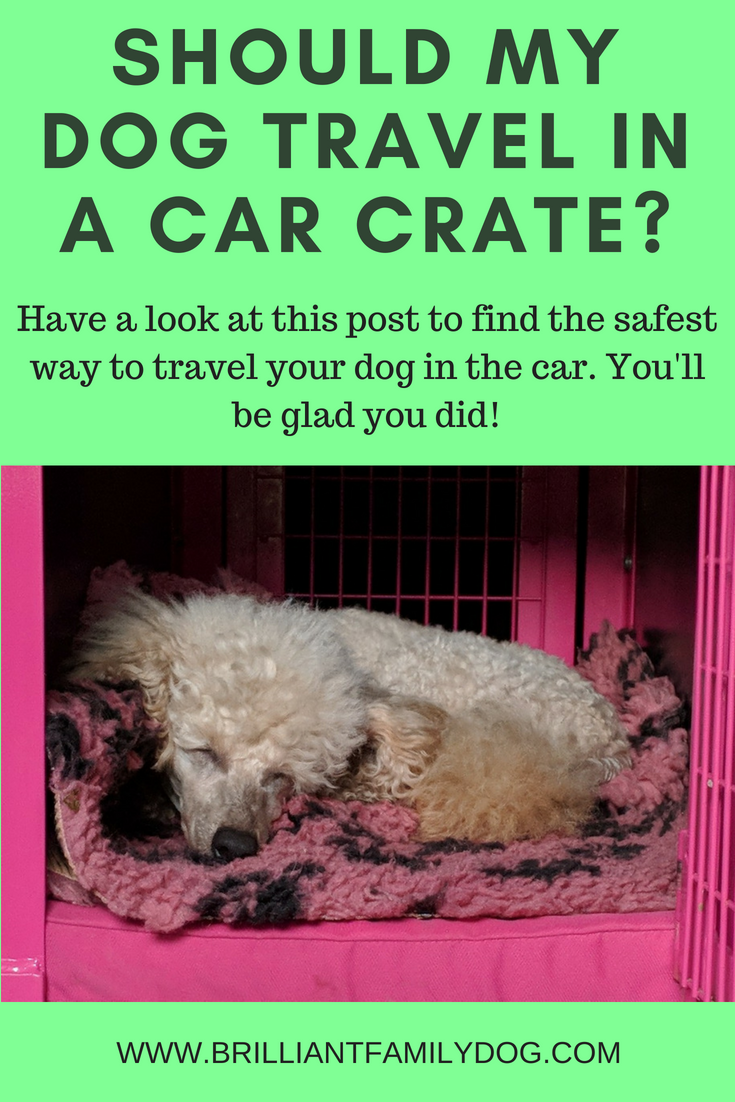
Credit: www.brilliantfamilydog.com
Selecting The Best Spot In The Suv
When traveling with a dog in an SUV, the safest spot is in the back seat, secured with a harness or in a crate. This minimizes distractions and ensures the dog’s safety in case of sudden stops or accidents. Placing a non-slip mat or cover can also provide additional stability for the pet.
Safety Implications Of Seating Areas
When it comes to traveling with your beloved furry friend in an SUV, selecting the best spot is of utmost importance for their safety and well-being. The seating area you choose can have significant implications for their overall safety during the journey.
Dogs should never be allowed to roam freely within the vehicle while it’s in motion. Not only can this be a distraction for the driver, but it also puts the dog at risk of injury in the event of sudden braking or a collision. Therefore, it’s essential to secure your dog in a designated spot within the SUV.
There are a few key factors to consider when selecting the best spot for your dog:
- Accessibility: Choose a spot that allows easy access to your dog without compromising the safety of the driver or passengers.
- Comfort: Ensure the spot provides enough space for your dog to sit or lie down comfortably during the journey.
- Visibility: Opt for a location that allows your dog to see and interact with you or other passengers without obstructing the driver’s view.
- Temperature: Be mindful of the temperature inside the vehicle and select a spot that provides adequate ventilation and avoids direct exposure to extreme heat or cold.
Impact Of Airbags On Dog Safety
When considering the safety of your dog in an SUV, it’s crucial to be aware of the potential impact of airbags. While airbags are designed to protect human occupants in the event of a collision, they can pose a serious risk to dogs.
Airbags deploy with considerable force, and if your dog is positioned in front of an airbag, they could sustain severe injuries. Therefore, it is highly recommended to never allow your dog to ride in the front passenger seat, especially if the airbag cannot be deactivated.
Instead, the safest spot for your dog is in the backseat of the SUV. If your vehicle has rear airbags, make sure they are turned off to prevent any accidental deployment that could harm your furry companion.
Remember, the safety and well-being of your dog should always be a top priority when traveling in an SUV. By selecting the best spot and being mindful of the potential risks associated with airbags, you can ensure a safe and enjoyable journey for both you and your beloved pet.
Barrier Systems For Suvs
Ensure the safety of your dog in an SUV with a reliable barrier system. Traveling with a dog in an SUV can be safest when using a barrier system specifically designed to keep pets secure and comfortable during the journey.
This type of system offers a secure and stress-free way to transport your furry friend.
Types Of Barriers
When traveling with your dog in an SUV, using a barrier system is crucial for safety.
There are two main types of barriers for SUVs:
- Mesh Barriers: Easily installable and provide a visual barrier.
- Metal Barriers: More durable, offering better protection in case of an accident.
Installing And Using Barriers
Installing a barrier in your SUV is a simple process that involves:
- Measuring the width of your vehicle to ensure a proper fit.
- Attaching the barrier securely to the headrests or cargo area.
Once installed, follow these tips for using the barrier effectively:
- Train your dog to get used to the barrier before traveling.
- Check the barrier regularly for any signs of wear or damage.
Temperature Control And Ventilation
Traveling with your furry friend is always an adventure, but it’s important to make sure they are safe and comfortable during the trip. One of the most important aspects of traveling with a dog in an SUV is temperature control and ventilation. Dogs are sensitive to temperature changes and can quickly become uncomfortable or even experience health issues if not properly regulated.
Preventing Heatstroke And Hypothermia
In hot weather, it’s essential to prevent heatstroke by keeping your dog cool. Avoid leaving them in the car for extended periods, even with the windows cracked. Instead, park in a shaded area and use a sunshade to protect the interior from direct sunlight. Provide plenty of water and use air conditioning or fans to keep the air circulating.
On the other hand, in cold weather, hypothermia is a risk, and it’s important to keep your dog warm. Use blankets or a dog bed to provide insulation, and consider using a dog coat or sweater. Avoid leaving your dog in the car for long periods of time, especially in sub-zero temperatures, as this can be dangerous.
Ensuring Adequate Airflow
Adequate airflow is essential for your dog’s comfort and health. Make sure your SUV has functioning air conditioning and heating systems, and regularly replace air filters to maintain good air quality. If your dog is in a crate, make sure there are openings for air to circulate, and if they are loose in the car, open the windows slightly to allow fresh air to flow.
If you’re traveling with multiple dogs, ensure that they have enough space to move around and access to fresh air. Avoid overcrowding, as this can lead to overheating and discomfort.
By following these tips for temperature control and ventilation, you can ensure that your furry friend stays comfortable and safe during your SUV adventures.
Preparing For Long Road Trips
Packing A Dog Travel Kit
When preparing for a long road trip with your dog in an SUV, it’s crucial to pack a comprehensive dog travel kit. This kit should include essential items such as a leash, water and food bowls, enough food and water for the journey, waste disposal bags, a favorite toy, and any necessary medications. It’s important to have these items easily accessible during the trip to ensure your dog’s comfort and well-being.
Planning For Frequent Breaks
Another vital aspect of preparing for a long road trip with your dog in an SUV is planning for frequent breaks. Dogs need to stretch their legs and relieve themselves regularly during long journeys. Plan your route to include regular stops at dog-friendly rest areas or parks where your furry companion can take a break and get some exercise. This will help reduce their anxiety and make the journey more enjoyable for both of you.
Emergency Preparedness And First Aid
When traveling with your dog in an SUV, it’s crucial to be prepared for any potential emergencies or accidents. Creating a doggie first aid kit and knowing what to do in case of an accident are essential components of ensuring the safety and well-being of your canine companion.
Creating A Doggie First Aid Kit
Having a well-stocked first aid kit specifically designed for your dog can be a lifesaver in unexpected situations. Here’s a list of items to include:
- Bandages
- Antiseptic wipes
- Hydrogen peroxide
- Gauze pads
- Adhesive tape
- Rectal thermometer
- Tick removal tool
- Scissors
- Antibiotic ointment
- Canine first aid manual
What To Do In Case Of An Accident
Being prepared for an accident is crucial when traveling with your dog. In the event of a car accident, here are the steps to take:
- Check for injuries: Assess your dog’s condition and administer first aid if necessary.
- Secure the area: If it’s safe to do so, move your dog to a secure location away from traffic.
- Seek veterinary care: Even if your dog appears uninjured, it’s important to seek professional veterinary evaluation as soon as possible.
- Document the incident: Take photos of the accident scene and any injuries sustained by your dog for insurance and legal purposes.
Training And Behavior Management
Traveling with your dog in a SUV requires proper training and behavior management. The safest way to travel with a dog in a SUV is to use a crate or a harness to secure them, and to make sure they are comfortable and have access to water and fresh air during the journey.
Traveling with a dog in an SUV can be a lot of fun, but it requires planning and preparation to ensure a safe and comfortable ride for both you and your furry friend. Training and behavior management are crucial factors that can make the journey enjoyable for your dog and less stressful for you. Here are some tips to acclimate your dog to travel, manage anxiety and motion sickness.Acclimating Your Dog To Travel
It’s essential to make your dog feel comfortable with the SUV before embarking on a long journey. Start by introducing your dog to the vehicle and let them explore it at their own pace. You can also use treats or toys to encourage them to hop in and out of the car. Once your dog is comfortable being in the SUV, take them on short rides to help them get used to the motion and sounds. Gradually increase the duration and distance of the trips.Managing Anxiety And Motion Sickness
Many dogs experience anxiety and motion sickness during car rides. To prevent this, it’s recommended to avoid feeding your dog a big meal before the trip. You can also use herbal supplements or medication prescribed by your veterinarian to calm your dog’s nerves. Additionally, make sure your dog has access to fresh water and air during the ride. If your dog shows signs of motion sickness, such as drooling or vomiting, take a break and let them rest. In conclusion, acclimating your dog to travel and managing their anxiety and motion sickness are key to a safe and enjoyable ride in an SUV. By taking the time to prepare your dog and address any behavioral issues, you can ensure a stress-free journey for both you and your furry friend.Legal Considerations And Insurance
Before hitting the road with your furry friend, it’s crucial to understand pet travel laws to ensure compliance.
- Research specific laws regarding pet travel in your state.
- Ensure your dog is properly secured in the vehicle.
- Check if there are any restrictions on pet transportation in your area.
When traveling with your dog in an SUV, consider insuring your dog to protect against unforeseen circumstances.
- Look into pet insurance policies that cover travel-related incidents.
- Ensure your insurance policy includes coverage for pet injuries during travel.
- Verify if your current insurance covers any pet-related accidents in the vehicle.
Frequently Asked Questions
Where Is The Safest Place For A Dog In A Suv?
The safest place for a dog in an SUV is in the back seat, secured with a dog seat belt or in a secured crate. This ensures that the dog is protected in case of sudden stops or accidents, reducing the risk of injury to both the dog and passengers.
How To Safely Transport Dog In Suv?
Secure your dog in SUV using a harness or carrier. Keep windows closed and avoid loose objects. Use a pet barrier for safety. Take breaks for walks and water. Never leave your dog unattended in the vehicle.
Is It Safe To Put A Dog In The Trunk Of A Suv?
It is not safe to put a dog in the trunk of an SUV due to potential injury risks.
Where Should Dog Sit In Suv?
Place your dog in the back seat or cargo area of the SUV, secured with a pet seat belt or crate.
Conclusion
Traveling safely with your dog in an SUV is crucial for a stress-free journey. By using proper restraints and creating a comfortable space, you can ensure your pet’s safety. Remember to plan ahead and prioritize your furry friend’s well-being for a smooth and enjoyable trip together.
- Can I Get in a Taxi Without a Car Seat? - January 26, 2025
- Can I Get Chlamydia From a Toilet Seat? - January 26, 2025
- Can I Get an Uber With a Car Seat? - January 26, 2025


